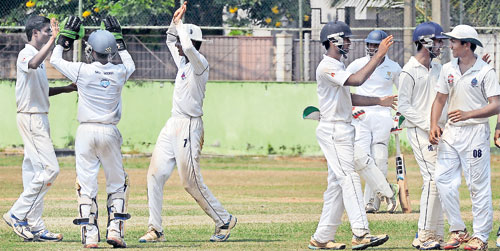Book on Antonian cricket
 Afzal’s book on Antonian cricket is timed to coincide with the Centenary encounter between Trinity College and St. Anthony’s College to be played on March 9 and 10 at the Pallekele Stadium.
Afzal’s book on Antonian cricket is timed to coincide with the Centenary encounter between Trinity College and St. Anthony’s College to be played on March 9 and 10 at the Pallekele Stadium.
Afzal was a popular journalist whilst in Sri Lanka and wrote to the Island, until he migrated to Australia where his writing has been prolific and well accepted. The attraction to his articles and publications is his candid accounts which have been faithfully researched and replete with incidents which are authentic and exciting to say the least. By profession he is an engineer and his skills as an engineer perhaps help him to construct and put together highly entertaining material.
His recent attempt to chart the history of Antonian cricket is also very much an effort to stay within the realms of authenticity and he scorns flourishes which are generally found in these publications that abound nowadays. The tendency in this day and age is to make supermen out of mere pedestrian beings, a trap into which Afzal never falls!
Antonian Cricket spans the full 20th Century and Afzal’s monumental work is remarkable in that in he captures the essential statistics of this period relying on available accounts.
The true characters to be remembered for their feats are referred to by Afzal in a refreshing manner. He refers to what is known of the greats of the early years. Of course, the book had to give pride of place to the great Jack Anderson, who is reputed to have put Antonian cricket on the map. There is also reference to LV Jayaweera, who was known better outside the college, as a boxer who was a national champion; and the great Baie, whose bowling performances have been phenomenal. He once was responsible for bowling out the Josephians for a mere 23 runs!
One has to remember that St. Anthony’s was badly affected by the war years when the school was occupied by the British Forces. The revival came, it is said with the infusion of the coaching skills of the doyen of cricket coaches, John Halangoda, on whom a special piece is included.
The 1950’s saw St. Anthony’s produce some amazing talent. A C M Lafir, who opened the batting for the Antonians and established a stupendous stand of 266 for the first wicket with Ronnie Stevens against Trinity in the year which marked the Centenary of the school, 1954; was a consistent and reliable performer. He is given pride of place in the account of the 1950’s. The team of 1954 was, arguably the best produced by the school and Afzal, has much to say about the season as well as the man who was instrumental in honing their techniques, John Halangoda.
Straddling the two decades, the 1950’s and 1960’s was one colossus named Charlie Joseph who was the Schoolboy cricketer of the year in 1959 and again in 1960. Afzal deals with his amazing statistics and recounts the famous stand of the brothers Charlie and Michael, both of whom got centuries in a record stand against a fiery bowling attack of Dharmaraja College led by TB Kehelgamuwa. Also in the 1960’s the Antonians produced Franklyn Burke and Jayantha Udukumbura who won the coveted Schoolboy cricketer of the year accolade. Jayantha and his mate Nagendra were a formidable pair who plundered many runs as excellently related by Afzal.
In the early 1970’s one name which stands out from among many great names, is that of Mahes Gunatilleke, who was a brilliant batsman and one of the best ever wicket-keepers, which propelled him into the national side. The accounts for the matches and some sterling innings in the 1970’s is covered with details which are worthy of note.
The 1990’s were also unforgettable and we saw Piyal Wijetunge, Muttiah Muralitharan and Ruwan Kalpage play for Sri Lanka in one and the same team, having done tremendous service for their school. Murali wove a web round the school boy batsmen and was school boy cricketer of the year in 1991. His feats at international level, however, now eclipse his equally great school stats. Afzal covers the 1990’s with the intensity it richly deserves.
The brothers who adorned the Antonian cricket stage perhaps deserve special mention as Antonian cricket was replete with them – the three Joseph brothers, the three Sims brothers and the three Burke brothers have left a rich legacy which is captured by Afzal.
Time and space does not permit me to say more about this book which is a must read for all sports lovers.
Franklyn Amerasinghe


